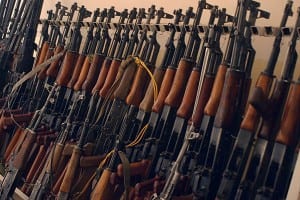After months of presidential campaigning with little to no discussion on gun control, gun owners were starting to wonder if the candidates would ever be forced to declare their positions. Then, all of a sudden during the second presidential debate, there it was. Undecided voter Nina Gonzalez asked President Barack Obama what his administration “has done or plans to do to limit the availability of [so-called] assault weapons.”
“We’re a nation that believes in the Second Amendment, and I believe in the Second Amendment,” Obama said. “We’ve got a long tradition of hunting and sportsmen and people who want to make sure they can protect themselves.”
OK. So far, so good.
“But there have been too many instances during the course of my presidency, where I’ve had to comfort families who have lost somebody,” the president continued, “Most recently out in Aurora.”
And here we go.
“Weapons that were designed for soldiers in war theaters don’t belong on our streets,” the president said. “And so what I’m trying to do is to get a broader conversation about how do we reduce the violence generally. Part of it is seeing if we can get an assault weapons ban reintroduced.”
With that 30-second sound bite, Obama resurrected the favorite bogeyman of the anti-gun left: semi-automatic rifles. The ramifications were swift. The NRA ramped up its ad campaign. The Brady Campaign’s phones rang for the first time in years. And suddenly the nation was thrust back into a debate over a widely owned category of firearms.
However, if you’ve ever participated in the discussion, you’ve likely experienced an unfortunate frustration: The public has been intentionally misled by anti-gun groups regarding firearms law, the capabilities of semi-automatic firearms, and the effect of Bill Clinton’s 1994 Assault Weapons Ban. In fact, you may have even talked to a few actual gun owners who have their facts confused. So, let’s take a look at the history of the original law, including what guns it banned, its effect on crime, the attempts to reinstate it and what a new assault weapons ban may look like.
The Real Assault Weapons Ban
First, an important clarification: The semi-automatic rifles affected by the 1994 Assault Weapons Ban are not, by true definition, assault rifles. There are several reasons why, but the most important distinction is they aren’t capable of fully automatic fire.
However, when the average non-gun owning citizen hears “assault weapon,” he hears “machine gun,” even though the National Firearms Act (NFA) of 1934 already requires such firearms to be heavily taxed, highly regulated and registered with the federal government. Therefore, Bill Clinton truthfully did not ban assault rifles—FDR did.
Yet how many folks have you run into who assume you can just waltz into a gun store and buy an automatic rifle? They’ve been fed misleading information on this issue. And that’s arguably the greatest victory ever scored by anti-gun groups: They’ve won public support by incorrectly branding semi-auto rifles as “assault weapons.” With a little help from the mainstream media, of course.
Bill Clinton’s Assault Weapons Ban
Once the term “assault weapon” became part of the American lexicon sometime in the late ’80s, gun rights were in a sorry state of retreat. In 1989, California banned “assault weapons,” followed by New Jersey in 1990. Soon Connecticut, Massachusetts, Hawaii, Maryland and New York passed similar bans.
Then came the greatest blow of all: On Sept. 13, 1994, Congress passed the Violent Crime Control and Law Enforcement Act, which included the Federal Assault Weapons Ban (AWB). President Bill Clinton signed it into law on the same day.
The AWB prohibited the manufacture of certain semi-automatic firearms (those made prior to the AWB could still be legally owned and sold). One of the most interesting if not disturbing aspects of the AWB was the criteria it used to define a so-called “assault weapon.” Critics argued that the criteria consisted merely of cosmetic features that appeared scary to the bill’s authors, but did nothing to prevent crime. You be the judge: Here are the firearm characteristics that were covered by the AWB.
Rifle prohibitions:
- Bayonet mounts
- Barrel shrouds
- Folding or telescoping stocks
- Flash suppressors or barrels threaded to accept them
- Pistol grips
Pistol prohibitions:
- Magazines that attach outside the pistol grip
- Any semi-auto version of a fully automatic pistol
- Barrels threaded to accept extensions, suppressors, flash suppressors, or handgrips
- Barrel shrouds
- Pistols with unloaded weights of 50 ounces or more
Shotgun prohibitions:
- Magazine capacities of five shells or more
- Folding or telescoping stocks
- Pistol grips
- Detachable magazines
Additionally, 19 models of firearms were specifically banned by name, as were magazines or other feeding devices with capacities of 10 rounds or more. However, moderate lawmakers in Congress were able to attach a “sunset” provision to the AWB that provided for its expiration after 10 years.
Effects of the Assault Weapons Ban
The AWB significantly raised the market value of pre-ban firearms and led to production of a lot of fixed-stock AR-15s, but did it actually do what its proponents said it would—save lives?
According to the vast majority of research, including by the University of Pennsylvania and a Congressionally mandated study by the U.S. Department of Justice, the AWB neither increased nor decreased violent crime. The government’s study argued it would be difficult to determine the effect of the AWB one way or another, because the guns it affected were used in only a small fraction of crimes prior to the ban.
There is one study that suggests the AWB had a positive effect on crime, but it was funded by—guess who—the Brady Campaign.
Another effect of the AWB had nothing to do with firearms: It mobilized pro-gun voters. President Clinton largely credits gun owners with fueling the Republican Revolution of 1994 and defeating Al Gore in 2000.
Renewal Efforts
Despite efforts by Rep. Carolyn McCarthy, D-N.Y., and Sen. Dianne Feinstein, D-Calif., to renew the AWB, it expired on March 2, 2004. Since that time, McCarthy has reintroduced an AWB in 2003, 2005, 2007 and 2011—none of her bills have made it out of committee.
What might a new ban look like if it ever again reaches the president’s desk? We can be fairly certain there’d be no expiration date this time around. None of McCarthy’s bills have included one, and she’s made it clear she wants a permanent ban. A new McCarthy ban would also likely prohibit all of the gun accessories covered by the 1994 AWB (despite the embarrassing admission that McCarthy doesn’t even understand some of them), plus a few others, including fixed-magazine centerfire rifles holding ten or more rounds, certain semi-auto shotguns, and detachable-magazine semi-auto rifles.
In short, a new assault weapons ban would likely have farther reach and it would be here to stay. How can we ensure that doesn’t happen? If you haven’t heard, there’s an election in two weeks. Perhaps it’s time to mobilize the same huge bloc of voters that sent Mr. Clinton’s allies a simple message in ’94: Go after our guns and we’ll vote you out.



